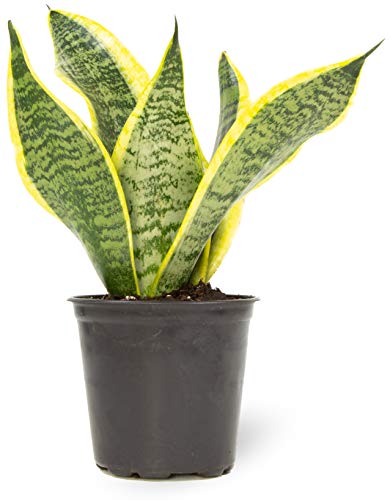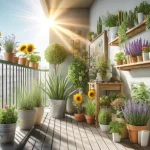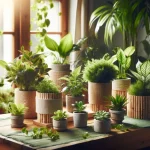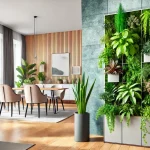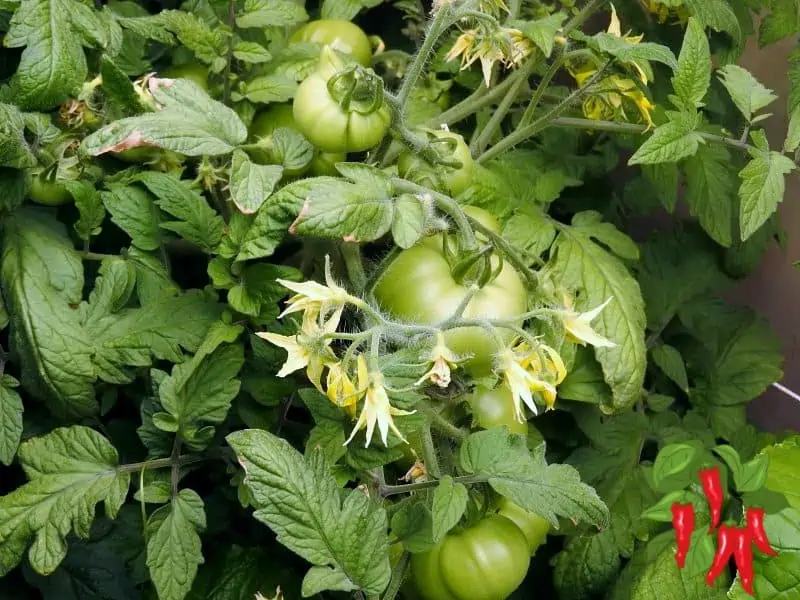This post may contain affiliate links. If you buy something from one of our links we may earn a commission. Thanks
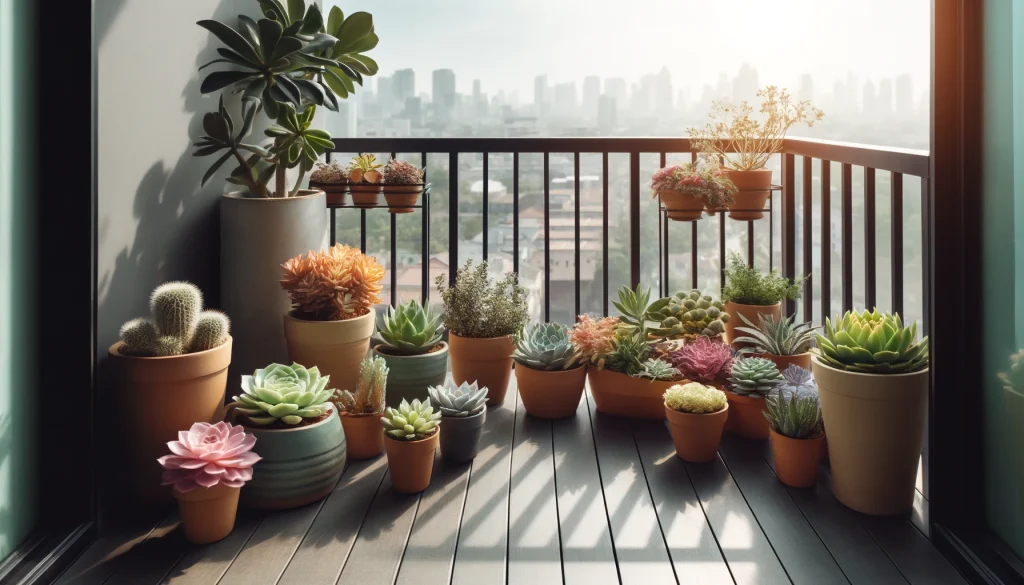
Low-maintenance balcony plants are a fantastic way to bring greenery and life to your outdoor space without requiring a significant amount of time and effort to care for them.
These plants offer several benefits and can enhance the aesthetics of your balcony while improving the air quality and creating a relaxing environment.
The low-maintenance nature of these plants means you can enjoy their beauty without dedicating hours to their upkeep.
When choosing low-maintenance balcony plants, factors such as lighting conditions, climate and weather resistance, space availability, and watering needs should be taken into consideration.
To help you get started, here are the top 10 low-maintenance balcony plants, including Snake Plant, ZZ Plant, Pothos, Spider Plant, Sedum, Peace Lily, Aloe Vera, Jade Plant, Cactus, and Succulents.
To ensure the well-being of your low-maintenance balcony plants, some tips for caring for them include choosing the right pot and soil, providing adequate watering, using fertilizers sparingly, and regularly removing dead leaves and pruning.
Benefits of Low-maintenance Balcony Plants
Turn your balcony into an oasis with low-maintenance plants! Discover the incredible benefits they bring to your outdoor space.
From adding a touch of greenery and enhancing aesthetics to improving air quality and creating a relaxing environment, these plants have got you covered.
The best part? They require minimal time and effort to maintain, allowing you to enjoy all the perks without the hassle.
Get ready to transform your balcony into a tranquil retreat with these easy-care plants!
Add Greenery and Aesthetics
Adding greenery and aesthetics to your balcony has numerous benefits and can greatly enhance the overall appearance of your outdoor space.
The addition of plants not only adds a touch of natural beauty but also creates a welcoming and calming environment.
Including plants on your balcony can transform a dull and boring space into a lush green oasis.
The vibrant colors and diverse foliage of plants add visual interest and create a vibrant atmosphere.
Whether you choose flowering plants, leafy greens, or a combination of both, the inclusion of greenery instantly uplifts the aesthetics of your balcony.
The presence of plants also helps to purify the air. They act as natural air filters, absorbing pollutants and releasing fresh oxygen.
This not only improves the air quality but also contributes to the overall beauty of your balcony.
In terms of aesthetics, plants can provide privacy and act as natural barriers, shielding your balcony from prying eyes and adding a sense of seclusion.
Additionally, they soften harsh architectural lines and bring a touch of serenity to your outdoor space.
When selecting plants to incorporate greenery and aesthetics into your balcony, consider factors such as lighting conditions, climate and weather resistance, space availability, and watering needs.
Choose plants that thrive in your specific conditions to ensure their long-term health and beauty.
Adding greenery and aesthetics to your balcony through the use of plants brings numerous benefits to your outdoor space.
It not only enhances the overall appearance but also improves air quality and creates a soothing and relaxing environment. Select plants that are suitable for your balcony’s conditions and enjoy the beauty and tranquility they bring.
Improves Air Quality
Improving air quality is one of the key benefits of having low-maintenance balcony plants.
These plants have the natural ability to filter and purify the air, creating a healthier environment for us to breathe.
They help remove pollutants such as formaldehyde, benzene, and trichloroethylene, thus improving overall air quality.
Additionally, plants release oxygen during photosynthesis, increasing oxygen levels in the surrounding air.
This oxygen production is particularly beneficial in urban areas where air pollution is a concern.
Furthermore, plants regulate humidity by releasing moisture through transpiration, which is especially helpful in dry environments and during the winter months when heating systems tend to dry out the air.
By absorbing carbon dioxide and releasing oxygen, low-maintenance balcony plants also contribute to reduced carbon dioxide levels in their surroundings.
Apart from these direct benefits, the presence of greenery and plants has been shown to have a positive impact on mental health and well-being.
Sarah, a busy professional living in a polluted city, experienced the positive effects of low-maintenance balcony plants firsthand.
By filling her balcony with these plants, she noticed a significant difference in air quality within her home.
Sarah could breathe easier and felt a sense of freshness that wasn’t present before.
These plants not only enhanced the aesthetics of her balcony but also made a positive impact on her overall well-being.
Sarah continues to enjoy the benefits of improved air quality and the calming presence of her low-maintenance balcony plants.
Creates a Relaxing Environment
Creating a relaxing environment is one of the benefits that low-maintenance balcony plants offer.
The presence of greenery and nature has been scientifically proven to induce feelings of relaxation and tranquility.
Being surrounded by plants can contribute to stress reduction, mood improvement, and the establishment of a peaceful atmosphere.
Various studies have demonstrated that being in the company of plants and greenery can effectively decrease blood pressure, alleviate anxiety, and foster a sense of calmness.
Moreover, the natural beauty and serene colors of plants can enhance the aesthetic appeal of your balcony, transforming it into a tranquil oasis where you can find solace.
In order to truly create a relaxing environment using balcony plants, it is crucial to carefully select foliage with soft and calming characteristics, such as peace lilies or snake plants.
Additionally, incorporating scented plants like lavender or jasmine can further enhance the soothing atmosphere by introducing pleasant aromas.
To maximize the relaxing benefits, it is advisable to place your plants in areas of the balcony where you frequently spend time, such as near seating areas or loungers.
The gentle rustling of leaves in the breeze can provide soothing background noise, enriching the overall atmosphere.
Pro-tip: To enhance the relaxing ambiance, consider adding elements like wind chimes, outdoor lighting, and comfortable seating.
These additional touches can contribute to creating a space where you can unwind and fully enjoy the tranquility provided by your low-maintenance balcony plants.
Requires Less Time and Effort to Maintain
When it comes to low-maintenance balcony plants, one of the key factors to consider is their ability to require less time and effort to maintain. Here are some reasons why these plants are a great choice for busy individuals:
Self-sufficiency:
Low-maintenance plants require less time and effort to maintain as they have the ability to thrive with minimal care.
They are resilient and can withstand periods without watering or regular attention. This makes them perfect for those who may not have a lot of time to dedicate to plant care.
Slow growth:
These plants tend to have slower growth rates compared to other species.
This means you won’t have to worry about constantly pruning or trimming them to keep them in shape.
They will maintain their size and shape without much intervention, which requires less time and effort to maintain.
Drought tolerance:
Low-maintenance plants often have high drought tolerance, meaning they can withstand periods without water.
This is particularly beneficial for those who may forget to water their plants regularly or are often away from home.
Their ability to survive without frequent watering requires less time and effort to maintain.
Minimal fertilization requirements:
These plants typically have lower fertilizer needs compared to high-maintenance plants.
They can obtain the necessary nutrients from the soil and do not require frequent fertilization.
This saves time and effort in maintaining their nutrient balance, which requires less time and effort to maintain.
By choosing low-maintenance balcony plants that require less time and effort to maintain, you can enjoy the beauty and benefits of greenery without the stress of constant upkeep.
These plants offer convenience and still bring life and aesthetics to your balcony space.
Factors to Consider When Choosing Low-maintenance Balcony Plants
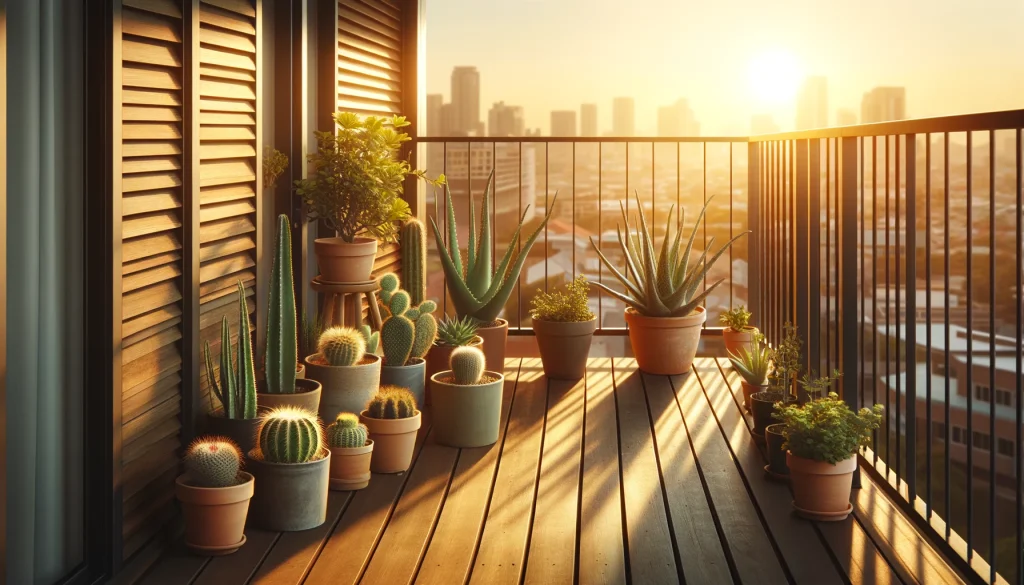
When it comes to selecting low-maintenance balcony plants, there are several factors to consider to ensure success.
We’ll explore different aspects like lighting conditions, climate adaptability, available space, and watering needs to help you choose wisely.
Let’s dive into the world of balcony gardening and uncover the secrets of finding the perfect low-maintenance plants that will thrive in your outdoor space.
Lighting Conditions
When it comes to choosing low-maintenance balcony plants, considering the lighting conditions is crucial for their growth and well-being. Here are some factors to keep in mind:
- Adequate sunlight: Different plants have varying light requirements. Some plants thrive in direct sunlight, while others prefer partial shade. Assess the amount of sunlight your balcony receives throughout the day and choose plants accordingly.
- Indoor vs. outdoor lighting: If your balcony is covered or enclosed, the available natural light may be limited. In such cases, opt for plants that can thrive in low-light conditions, such as snake plants or ZZ plants.
- Artificial lighting: If your balcony doesn’t receive sufficient natural light, you can supplement it with artificial lighting. LED grow lights are a popular choice as they provide the specific spectrum of light needed for plant growth.
- Seasonal changes: Consider how the lighting conditions might change with the seasons. Some plants may require more sunlight during the summer months, while others can tolerate lower light levels during winter.
Pro-tip: Regularly monitor the lighting conditions on your balcony and observe how the plants respond.
If you notice signs of sunburn or excessive stretching, adjust their placement or provide additional shade.
Remember, finding the right balance of light is essential for the healthy growth of your low-maintenance balcony plants.
Climate and Weather Resistance
When selecting low-maintenance balcony plants, it is crucial to take into account their climate and weather resistance.
A key factor to consider is the climate suitability of the plants for your area.
This includes considering the average temperature, humidity levels, and the occurrence of extreme weather events such as frost, strong winds, or excessive heat.
Opt for plants that are known to thrive in your specific climate.
If you live in an area with limited water availability or experience frequent dry spells, prioritize plants with high drought tolerance.
These plants can survive with minimal watering and endure long periods without rainfall.
For regions with cold winters, it is essential to choose plants that can withstand frost and freezing temperatures.
Look for plants described as cold-hardy or frost-tolerant.
On the other hand, if you reside in a hot and sunny climate, select plants that can handle intense sunlight and high temperatures without withering or scorching.
Seek out heat-tolerant varieties known for thriving in hot conditions.
In the case of strong winds on your balcony, opt for plants with sturdy stems and leaves that are less likely to be damaged.
By considering the climate and weather resistance of low-maintenance balcony plants, you can ensure they thrive in your specific environmental conditions.
This will make it easier for you to care for them and enjoy a beautiful balcony garden throughout the year.
True story: In 1982, a severe storm hit a small coastal town in Florida. The residents were amazed by the resilience of their balcony plants which had been carefully chosen for their climate and weather resistance.
Despite the strong winds and heavy rain, these plants stood tall and undamaged.
This event sparked a newfound appreciation for selecting plants suitable for the local climate, encouraging other residents to create vibrant balcony gardens capable of withstanding any weather condition.
Space Availability
When considering low-maintenance balcony plants, one important factor to take into account is the space availability.
| Apartment Size | Recommended Plants |
| Small balcony or limited space | Snake Plant, ZZ Plant, Pothos |
| Medium-sized balcony | Spider Plant, Sedum, Peace Lily |
| Large balcony or rooftop | Aloe Vera, Jade Plant, Cactus, Succulents |
If you have space available for a small balcony or limited space, it is best to choose plants that are compact and can grow well in confined areas.
Snake plants, ZZ plants, and pothos are great options as they don’t require much space and can thrive even in low-light conditions.
For those with a medium-sized balcony, you have a bit more room to work with. Spider plants, sedums, and peace lilies are perfect choices as they can add a touch of greenery without overcrowding the space available.
If you are lucky enough to have a large balcony or a rooftop garden, you can get more creative with your plant selection.
Aloe vera, jade plants, cacti, and succulents are ideal choices as they are hardy, drought-tolerant, and can withstand various weather conditions.
Remember to consider the size and growth habits of the plants you choose to ensure they fit well within your available space availability.
It’s also important to provide adequate sunlight and proper drainage for all plants to thrive.
Watering Needs and Drought Tolerance
When selecting low-maintenance balcony plants, it is important to consider their watering needs and drought tolerance. Here are some factors to keep in mind:
|
By considering these factors, you can select low-maintenance balcony plants that have watering needs and drought tolerance suitable for your outdoor space.
Top 10 Low-maintenance Balcony Plants
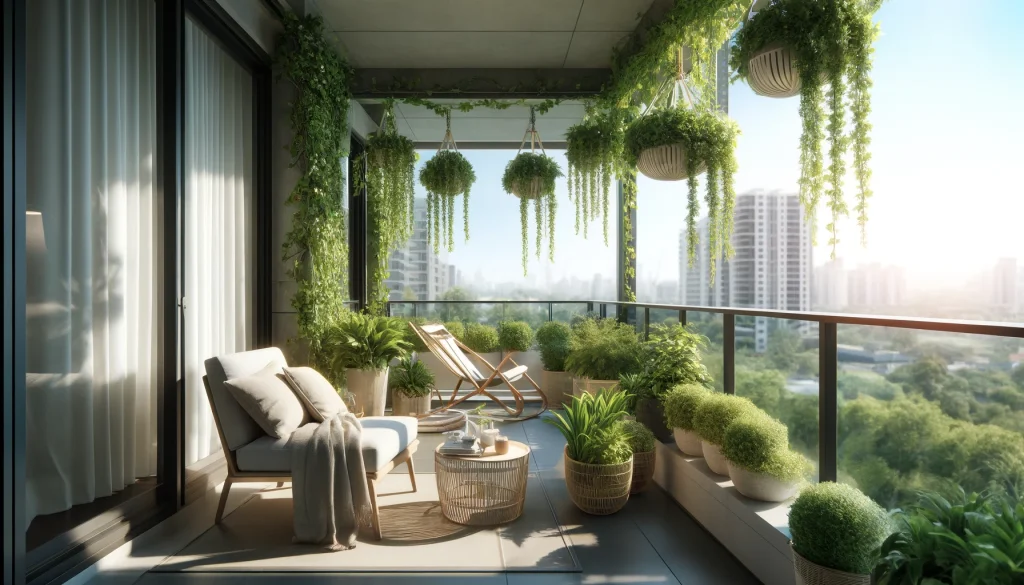
Looking to add some greenery to your balcony without the hassle of constant care? Look no further than our top 10 low-maintenance balcony plants!
From the resilient Snake Plant to the beautiful ZZ Plant, we’ll explore a variety of options that require minimal attention but still bring life and beauty to your outdoor space.
Hang tight as we dive into the world of low-maintenance balcony plants that will thrive in any urban setting.
Snake Plant
The snake plant, also known as Sansevieria, is a versatile and low-maintenance balcony plant that offers numerous benefits. When it comes to snake plants, there are several key points to consider.
One of the main advantages of snake plants is their natural air purifying ability. They are well-known for improving indoor air quality by removing toxins and releasing oxygen. Snake plants are particularly effective at filtering out formaldehyde and benzene.
Another great feature of snake plants is their hardiness and resilience. They can tolerate a wide range of lighting conditions, making them ideal for balconies with varying sun exposure.
Whether you have bright, indirect light or a low-light environment, snake plants can thrive.
In addition, snake plants are water-efficient. They have low water requirements and can withstand periods of drought.
This makes them perfect for busy individuals or those who may forget to water their plants regularly.
However, it’s important to let the soil dry out between waterings to avoid root rot.
When it comes to maintenance, snake plants are a breeze. They require minimal pruning and are not prone to pests or diseases.
This makes them an excellent choice for beginners or those with limited gardening experience.
Aside from their benefits, snake plants also provide aesthetic appeal to balcony spaces.
With their long, upright leaves in varying shades of green, they add a touch of elegance and visual interest.
Whether used as a focal point or as part of a larger arrangement with other plants, snake plants are sure to enhance the beauty of any balcony.
Overall, the snake plant is a reliable and visually appealing choice for low-maintenance balcony gardening.
Its air-purifying qualities, resilience, and easy care make it a popular option for those seeking hassle-free plants that offer numerous benefits.
ZZ Plant
The ZZ plant, also known as Zamioculcas zamiifolia, is an excellent low-maintenance balcony plant. Here are some important things to know about the ZZ plant:
- Easy to care for: The ZZ plant, also known as ZZ Plant, is renowned for its ability to thrive in low light conditions and tolerate neglect. This makes it perfect for beginners or those with busy lifestyles.
- Tolerant of various lighting conditions: The ZZ plant can adapt to a range of lighting conditions, from low light to bright indirect light. It is best to avoid direct sunlight as it can cause the leaves to burn.
- Drought tolerant: The ZZ plant, also known as ZZ Plant, has succulent-like qualities, storing water in its thick, fleshy stems and leaves. This enables it to withstand periods of drought, making it a resilient choice for balcony gardens.
- Air purifying properties: Like many other houseplants, the ZZ plant, also known as ZZ Plant, is known for its ability to improve air quality by removing toxins such as formaldehyde, benzene, and xylene from the surroundings.
- Glossy and attractive foliage: The ZZ plant, also known as ZZ Plant, has glossy, dark green leaves that add a touch of elegance to any balcony space. Its unique leaflets grow in pairs along the stem, giving it a visually interesting appearance.
- low-maintenance watering: The ZZ plant, also known as ZZ Plant, prefers to be slightly dry between waterings. It is important not to overwater as this can lead to root rot. Watering once every 2-3 weeks, or when the soil is dry to the touch, is usually sufficient.
The ZZ plant, also known as ZZ Plant, is a versatile and low-maintenance option for those looking to add some greenery to their balcony.
Its ability to thrive in various lighting conditions, drought tolerance, and air purifying properties make it an excellent choice for both beginner and experienced gardeners.
Pothos
Pothos |
| Pothos, also known as Epipremnum aureum, is a popular low-maintenance balcony plant that offers multiple benefits. |
| 1. Appearance: Pothos has heart-shaped leaves with variegations in colors like green, yellow, and white, making it visually appealing. |
| 2. Easy to grow: Pothos is a great choice for beginners as it is extremely easy to grow and requires minimal care. |
| 3. Light requirements: Pothos can tolerate a wide range of light conditions, including low light, making it suitable for balconies with varying levels of sunlight. It thrives best in bright, indirect light. |
| 4. Watering needs: Pothos is a drought-tolerant plant and can survive if you forget to water it occasionally. It is best to allow the top few inches of soil to dry out between waterings. |
| 5. Air purification: Pothos is known for its ability to purify the air by removing toxins like formaldehyde, xylene, and benzene. It improves indoor air quality, creating a healthier environment. |
| 6. Versatility: Pothos can be grown in hanging baskets, on trellises, or as a trailing plant. It can be easily propagated by stem cuttings, allowing you to expand your plant collection. |
| 7. low-maintenance: Pothos requires minimal grooming. Occasionally removing any yellow or dead leaves and giving it a wipe to keep the leaves clean is usually sufficient. |
| 8. Pet-friendly: Pothos is a non-toxic plant for pets, making it safe to have around cats and dogs. |
Spider Plant
The Spider Plant is a great choice for a low-maintenance balcony plant. Here are some key factors to consider when selecting and tending to a
- Lighting Conditions: Spider Plants prefer bright, indirect light but can also handle some shade. It is best to place them near a window or in an area with partial sunlight.
- Climate and Weather Resistance: Spider Plants have the ability to adapt and withstand different climates. They are tolerant of both hot and cold temperatures.
- Space Availability: Spider Plants are well-known for their cascading leaves, which makes them an ideal option for hanging baskets or raised planters.
- Watering Needs and Drought Tolerance: Spider Plants are relatively drought-tolerant and can endure occasional neglect. It is necessary to allow the soil to dry between waterings, but be careful not to let it completely dry out.
By following these guidelines, you can ensure that your Spider Plant thrives and enhances the beauty of your balcony.
Remember to choose the appropriate pot and soil, provide sufficient watering, and regularly remove any dead leaves to maintain the health of your Spider Plant.
Sedum
Sedum is a popular low-maintenance balcony plant that is easy to grow and requires minimal care. Here are some key points to consider when it comes to
- Hardiness: Sedum is a hardy plant that can tolerate a wide range of climates and weather conditions. It is resistant to drought and can thrive in both sunny and partially shaded areas.
- Growth habit: Sedum has a low, spreading growth habit, making it a great choice for ground cover or as a trailing plant in hanging baskets. It forms dense mats of foliage and produces clusters of colorful flowers.
- Watering needs: Sedum is a drought-tolerant plant that requires infrequent watering. It is important not to overwater the plant, as it can lead to root rot. Allow the soil to dry out between waterings.
- Soil requirements: Sedum prefers well-draining soil that is sandy or loamy. It can tolerate poor soil conditions and has low nutrient requirements.
- Maintenance: Sedum is known for its low-maintenance nature. It requires minimal pruning and deadheading. Regularly remove any dead or faded flowers to encourage new growth.
- Propagation: Sedum is easy to propagate through stem cuttings or by division. This makes it a great plant for sharing with friends or expanding your garden.
- Versatility: Sedum comes in a variety of colors and forms, providing options for different garden styles and aesthetics. Some popular varieties include Sedum ‘Autumn Joy’, Sedum ‘Purple Emperor’, and Sedum ‘Angelina’.
With its hardiness, low water requirements, and minimal maintenance needs, Sedum is a fantastic choice for anyone looking for a low-maintenance balcony plant.
Peace Lily
The peace lily is a popular choice for low-maintenance balcony plants because of its beautiful flowers and easy care requirements.
With its beautiful foliage, air purifying qualities, and easy care requirements, the peace lily is a top choice for those looking to incorporate low-maintenance balcony plants into their living spaces.
| Low light requirements: | Peace lilies, such as the peace lily, are well adapted to low light conditions and can thrive in areas with indirect or filtered sunlight. |
| Air purifying properties: | Peace lilies, including the peace lily, are known for their ability to remove toxins such as formaldehyde, benzene, and carbon monoxide from the air, making them excellent natural air purifiers. |
| Tolerant of occasional neglect: | Peace lilies, like the peace lily, are forgiving plants and can tolerate infrequent watering. They are able to recover quickly even if they are neglected for a period of time. |
| Watering needs: | While peace lilies, such as the peace lily, can tolerate occasional dryness, they prefer to be kept consistently moist. Water them when the top inch of soil feels dry to the touch, ensuring the roots are not sitting in standing water. |
| Easy to propagate: | Peace lilies, including the peace lily, can be easily propagated by dividing the plant at the root ball and replanting the divisions. This allows you to expand your collection or give plants as gifts. |
| Indoor and outdoor versatility: | Peace lilies, like the peace lily, can be grown both indoors and outdoors, making them a versatile choice for balconies. They can tolerate a range of temperatures but prefer to be kept in temperatures between 65-85 degrees Fahrenheit. |
| Non-toxic to pets: | Peace lilies, such as the peace lily, are considered non-toxic to cats and dogs, making them a safe choice for households with pets. |
Aloe Vera
When it comes to low-maintenance balcony plants, Aloe Vera is a fantastic option to consider. Here are some key reasons why:
- Aloe Vera is a resilient plant that can thrive with minimal care.
- It requires very little watering, making it suitable for those who may forget to water their plants regularly.
- With its succulent leaves, Aloe Vera stores water effectively, allowing it to withstand periods of drought.
- Aloe Vera is known for its air purification qualities as it absorbs harmful toxins and releases oxygen, improving the air quality on your balcony.
- The gel inside Aloe Vera leaves has various medicinal properties and can be used to treat minor burns, cuts, and skin irritations.
- Due to its attractive and distinctive appearance, Aloe Vera adds an aesthetically pleasing touch to your balcony.
- The plant is easy to propagate, so you can share its beauty with friends and family by growing new plants from the offsets.
- Aloe Vera is a versatile plant that can be grown in various containers or even as a hanging plant.
- It can tolerate a wide range of lighting conditions, from full sun to partial shade, making it adaptable to different balcony environments.
Choosing Aloe Vera as a low-maintenance plant for your balcony not only adds beauty but also offers health benefits and requires minimal effort to care for.
Jade Plant
The jade plant, also known as Crassula ovata, is a popular choice for low-maintenance balcony plants.
Jade plants are succulents, which means they have thick leaves that store water.
This makes them highly drought tolerant and perfect for busy individuals who may forget to water their plants regularly.
The jade plant is known for its unique and attractive appearance. It has thick, fleshy leaves that are shiny and oval-shaped, typically a vibrant green color, but they can turn red or purple in certain conditions.
One of the benefits of having a jade plant on your balcony is that it requires very little pruning.
You don’t need to spend a lot of time trimming or shaping the plant to keep it looking good. Lighting conditions are crucial for the jade plant’s health.
It prefers bright light, but direct sunlight can burn its leaves. Place the plant in a location where it receives indirect sunlight for a few hours every day.
When it comes to watering the jade plant, it’s important to strike the right balance. Overwatering can cause root rot, while underwatering can lead to shriveled leaves.
Allow the soil to dry out between waterings and water thoroughly when needed.
Incorporating a jade plant into your balcony garden will not only add a touch of beauty but also require minimal effort to maintain.
Enjoy the low-maintenance nature of this wonderful plant and the benefits it brings to your outdoor space.
Cactus
To provide information on the sub-topic “Cactus,” below is a table showcasing different types of cacti commonly used as low-maintenance balcony plants.
| Type of Cactus | Main Characteristics | Lighting Requirements | Watering Needs | Other Considerations |
| Prickly Pear Cactus | Thick, spiky pads with colorful flowers | Full sun to partial shade | Low water requirements, drought-tolerant | Well-drained soil, suitable for warmer climates |
| Barrel Cactus | Round shape with long spines | Full sun | Minimal water, extremely drought-tolerant | Suitable for arid and desert climates |
| Christmas Cactus | Segmented leaves and vibrant flowers | Indirect bright light | Moderate watering, avoid overwatering | Thrives in cooler temperatures |
While cacti are known for their ability to thrive in dry conditions, it is important to note that each type of cactus may have slightly different care requirements.
It is essential to research and understand the specific needs of the cactus you choose to ensure its proper growth and longevity.
Pro-tip: When caring for cacti, remember to water sparingly and provide adequate sunlight.
Overwatering is a common mistake that can lead to root rot.
Make sure to handle cacti with care, as their spines can cause injury.
With proper care, cacti can be a unique and vibrant addition to your balcony garden.
Succulents
- Variety: Succulents come in a wide range of shapes, sizes, and colors, offering plenty of options to choose from for your balcony.
- Drought tolerance: Succulents are well-known for their ability to store water in their leaves, stems, or roots, making them highly drought-tolerant plants.
- Low watering needs: Succulents require less frequent watering compared to other plants. Their water storage capabilities allow them to survive in dry conditions.
- Adaptability: Succulents can adapt to different lighting conditions, making them suitable for both sunny and partially shaded balconies.
- Aesthetics: Succulents have a unique and visually appealing appearance, with various textures and forms. They can add a touch of beauty and charm to your balcony.
- Indoor or outdoor use: Succulents are versatile plants that can thrive both indoors and outdoors, depending on your preference and balcony conditions.
- Low-maintenance: Succulents are known for their ability to thrive in neglect. They require minimal care, making them perfect for busy individuals or those with limited gardening experience.
- Propagation: Succulents are easy to propagate, making them an excellent choice for balcony gardens. You can easily grow more plants from leaves or stem cuttings.
- Air purification: Like other plants, succulents can help improve air quality by absorbing carbon dioxide and releasing oxygen.
- Decorative options: Succulents can be planted in various containers, such as pots, hanging baskets, or vertical gardens, allowing for creative and decorative arrangements on your balcony.
With their unique qualities and ease of care, succulents are an excellent choice for adding greenery and enhancing the aesthetics of your balcony space.
Tips for Caring for Low-maintenance Balcony Plants

Discover how to ensure the thriving growth of your low-maintenance balcony plants with these expert tips.
From selecting the perfect pot and soil combination to providing just the right amount of watering, we’ll guide you through the essentials.
Learn the art of sparingly using fertilizers and the importance of removing dead leaves and pruning for optimal plant health. Get ready to foster a green oasis on your balcony effortlessly.
Choose the Right Pot and Soil
To ensure the success and health of your low-maintenance balcony plants, it is essential to choose the right pot and soil. Follow these steps:
- Choose the appropriate pot size based on the plant’s size and growth potential. Opting for a larger pot will allow the roots of the plant to spread and grow properly.
- Ensure that the pot has drainage holes at the bottom to prevent waterlogging and root rot. This is crucial for maintaining the correct moisture level for your plants.
- If you plan to move the pot frequently, select a lightweight material such as plastic or fiberglass. For stationary pots, heavier materials like terracotta or ceramic can be chosen.
- For the soil, opt for a well-draining potting mix specifically formulated for container plants. This type of soil provides proper aeration and retains moisture as needed.
- Enhance the fertility and moisture-holding capacity of the soil by adding organic matter like compost or peat moss. This will supply essential nutrients to the plants.
- Avoid using garden soil alone as it tends to be heavy, compacted, and lacks proper drainage.
- Fill the pot with soil, ensuring there is sufficient space at the top for watering.
- Gently remove the plant from its nursery container, loosen any compacted roots, and place it in the center of the pot.
- Make sure the plant is at the same depth as it was in the nursery container. Fill the space around the roots with soil, gently pressing it down to eliminate air pockets.
- Finish by thoroughly watering the plant to settle the soil and hydrate the roots.
By following these steps and carefully selecting the right pot and soil for your low-maintenance balcony plants, you will create a healthy and supportive environment for their growth.
Provide Adequate Watering
When it comes to caring for low-maintenance balcony plants, providing adequate watering is crucial for their health and growth. Here are some important points to consider:
- Different plants have varying water requirements, so it’s important to understand the needs of your specific plants. Some plants, like cacti and succulents, prefer drier soil and should be watered sparingly. Others, like peace lilies and spider plants, prefer consistently moist soil.
- Watering method: It’s best to water plants at the base and avoid getting water on the leaves or flowers, as it can lead to fungal diseases. Use a watering can or a hose with a gentle spray nozzle to provide adequate watering for your plants.
- Check the soil moisture: Before providing adequate watering, check the moisture level of the soil by sticking your finger about an inch deep into the soil. If it feels dry, it’s time to water. If it still feels damp, you can wait a bit longer before providing adequate watering.
- Watering time: Provide adequate watering for your plants in the early morning or late afternoon, as watering during the hottest part of the day can cause water to evaporate quickly and not be absorbed by the plant’s roots.
- Drainage: Ensure that your pots have drainage holes to allow excess water to escape. Avoid letting your plants sit in standing water, as it can lead to root rot.
By providing adequate watering based on the specific needs of your plants, you can help them thrive and contribute to the beauty of your balcony.
In ancient Mesopotamia, one of the earliest known systems of irrigation was developed to provide adequate watering for crops.
The people of Mesopotamia, also known as the cradle of civilization, devised intricate methods of diverting water from rivers and canals to their fields to ensure the successful growth of crops.
This innovative approach to irrigation played a significant role in the flourishing of agricultural societies in the region, contributing to the overall development of civilization.
The ancient Mesopotamians recognized the importance of providing adequate watering to nurture their plants and reap bountiful harvests, highlighting the timeless significance of proper irrigation practices.
Use Fertilizers Sparingly
When caring for low-maintenance balcony plants, it is essential to use fertilizers sparingly for several reasons:
Environmental Impact: Using fertilizers excessively can result in environmental pollution.
Fertilizers contain nutrients that, if not absorbed by plants, can be discharged into water bodies, leading to problems like algal blooms and water contamination.
Regularly Remove Dead Leaves and Prune
- Regularly removing dead leaves and pruning is essential for maintaining the health and appearance of low-maintenance balcony plants. To uphold the well-being of your plants, follow these steps:
- Inspect your plants regularly for dead or yellowing leaves. It’s important to regularly remove dead leaves and prune promptly to prevent the spread of diseases or pests.
- Use a pair of clean and sharp gardening shears or scissors to carefully trim off the dead leaves. Make sure to cut them close to the stem, without damaging the healthy parts of the plant. Remember to regularly remove dead leaves and prune as needed to keep your plants in good shape.
- Prune any overgrown or leggy branches to encourage bushier growth. Look for nodes or leaf clusters and trim just above them to stimulate new growth. Regularly removing dead leaves and pruning helps maintain the desired shape and health of your balcony plants.
- Remove any damaged or diseased parts of the plant. This includes branches with signs of rot, mold, or insect infestation. Clearly, regularly removing dead leaves and pruning helps prevent the spread of problems, ensuring the overall well-being of your plants.
- Regularly check for and remove any spent flowers or fruits. This practice redirects the plant’s energy towards new growth and prevents unnecessary resource wastage. Don’t forget to routinely remove dead leaves and prune to promote healthier growth.
- After pruning, it’s advisable to clean your tools with disinfectant to avoid spreading diseases between plants. Remember that regularly removing dead leaves and pruning goes hand in hand with proper tool maintenance.
- Dispose of the pruned plant materials properly. Dead leaves and pruned branches can be added to a compost pile if you have one, or disposed of in green waste bins. Implementing the habit of regularly removing dead leaves and pruning also includes ethical and responsible waste management.
Regularly removing dead leaves and pruning not only keeps your low-maintenance balcony plants looking tidy but also promotes healthy growth and prevents problems from spreading.
By regularly removing dead leaves and pruning, you can ensure that your plants thrive and continue to beautify your balcony.
Frequently Asked Questions
1. How do low-maintenance balcony plants filter out pollutants?
Low-maintenance balcony plants have the ability to filter out pollutants from the air through a process called phytoremediation.
They absorb harmful gases and release oxygen, thus improving the air quality around them.
2. Can I place balcony plants near balcony grills?
It is not recommended to place balcony plants near balcony grills as the grills can restrict air circulation and cause damage to the plants. It is best to keep the plants a safe distance away from the grills.
3. How often should I tend to low-maintenance balcony plants?
Low-maintenance balcony plants require minimal care, but they still need some attention.
Generally, they need to be watered regularly, have proper drainage, and be protected from extreme weather conditions.
It is also important to remove any dead or damaged leaves to maintain their overall health.
4. What are the best plants for window boxes on a balcony?
Some of the best plants for window boxes on a balcony include sweet flowers like Lavender, Fuchsia, Sweet Alyssum, and Caladium.
These plants add color and beauty to your balcony while thriving in the limited space provided by window boxes.
5. Can I have plants in my living room that require lots of sun?
Yes, you can have plants in your living room that require lots of sun.
To ensure their proper growth, place these sun-loving plants near windows or in well-lit areas where they can receive direct sunlight.
Just make sure to monitor their moisture levels and provide them with the necessary care.
6. How can I prevent slow drying in balcony planters with coco fiber?
To prevent slow drying in balcony planters with coco fiber, it is recommended to mix a small amount of perlite or vermiculite with the coco fiber.
These materials increase drainage and promote faster drying of the soil. Additionally, ensure that the planters have proper drainage holes for excess water to escape.
Visit my Amazon Influencer Page for videos and gardening products Grow Your Own Garden

